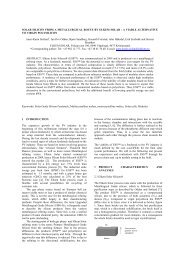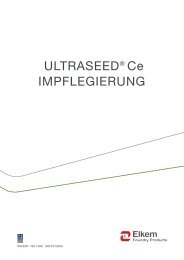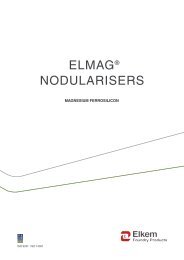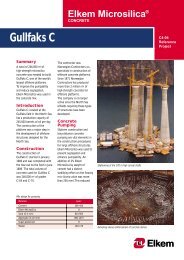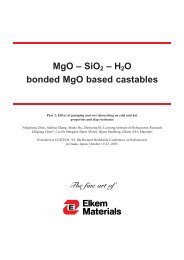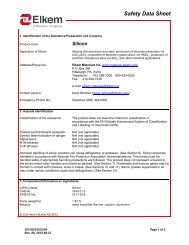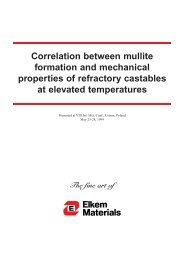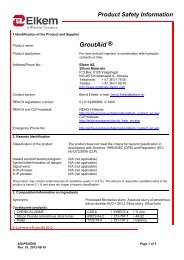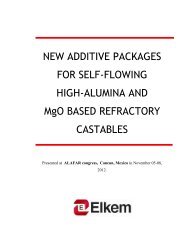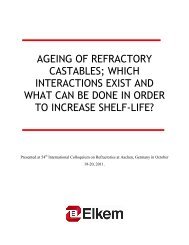The Use of Microsilica in Refractory Castables - Elkem
The Use of Microsilica in Refractory Castables - Elkem
The Use of Microsilica in Refractory Castables - Elkem
- No tags were found...
You also want an ePaper? Increase the reach of your titles
YUMPU automatically turns print PDFs into web optimized ePapers that Google loves.
Table 3: Low-cement castables with 6% cement. q-value = 0.25.<strong>Microsilica</strong>/reactive alum<strong>in</strong>a (vol%) 100/0 75/25 50/50 25/75 0/100Weight %:Cement (CA-14C) 6 6 6 6 6White fused alum<strong>in</strong>a:-74 micron 15 14.5 14.5 14 140-0.4mm 22 21.5 21 21 20.50.5-3mm 32 31.5 31 30.5 302-4mm 10 10 9.5 9.5 9.5<strong>Microsilica</strong> (983U) 8 6 4 2 0CT3000SG (superground alum<strong>in</strong>a) 0 3.5 7 10.5 13.5HVA SG (calc<strong>in</strong>ed alum<strong>in</strong>a) 7 7 7 6.5 6.5Citric acid (retarder) 0.03 0.03 0.05 0.05Darvan 811D (deflocculant) 0.05 0.05 0.05 0.05 0.05Water (13 vol%) 4.15 4.10 4.05 3.96 3.93<strong>The</strong> castables have all the same PSD, but the superf<strong>in</strong>es fraction is modified form puremicrosilica through mixtures to pure reactive alum<strong>in</strong>a (CT3000SG from ALCOA). <strong>The</strong>reactive alum<strong>in</strong>a was chosen because <strong>of</strong> similar PSD as microsilica when measured by laserdiffraction. When microsilica is substituted by reactive alum<strong>in</strong>a on a volume basis, then 2wt%microsilica has to be replaced by 3.5wt% reactive alum<strong>in</strong>a. <strong>The</strong> reason is the big difference <strong>in</strong>specific gravity <strong>of</strong> alum<strong>in</strong>a and microsilica (approx. 3.9 and 2.2 resp.). This <strong>in</strong>fluences all<strong>in</strong>gredients <strong>in</strong> the mixture as seen <strong>in</strong> the tables. However, the hydraulic components are keptconstant. It is well documented that the use <strong>of</strong> microsilica has a retard<strong>in</strong>g effect on the set <strong>of</strong>refractory castables. Likewise was it experienced that the reactive alum<strong>in</strong>a was an effectiveaccelerator. This was to such a degree that even for the no/ultralow-cement mixture one hadto use retarder to prevent flash-sett<strong>in</strong>g dur<strong>in</strong>g mix<strong>in</strong>g. Another effect caused by differences <strong>in</strong>density is that by substitut<strong>in</strong>g microsilica with reactive alum<strong>in</strong>a, the amount <strong>of</strong> water to make agiven volume percent water addition is lowered. <strong>The</strong> reason is that when the theoretical densityis <strong>in</strong>creased by the substitution <strong>of</strong> microsilica with alum<strong>in</strong>a, then the fraction occupied by agiven weight <strong>of</strong> water will <strong>in</strong>crease. To have a constant volume fraction water, the amount mustthus be reduced.<strong>The</strong> flow was measured on 3 kg samples immediately after 4 m<strong>in</strong>utes wet-mix<strong>in</strong>g. <strong>The</strong> flowvaluerepresents the percentage <strong>in</strong>crease <strong>in</strong> the diameter <strong>of</strong> a flow-cone as described <strong>in</strong> ASTMC230: <strong>The</strong> fresh castable was filled <strong>in</strong>to the cone placed on a vibration table, the cone wasremoved and the castable allowed to spread by gravity alone until spread<strong>in</strong>g ceased. Normallythe spread<strong>in</strong>g was f<strong>in</strong>ished after less than one m<strong>in</strong>ute. After measur<strong>in</strong>g the flow, the spreadcastables was subjected to 15 sec. <strong>of</strong> vibration at an amplitude <strong>of</strong> 0.75mm. <strong>The</strong> flow withoutvibration is termed free-flow and that after vibration, vibra-flow. A free-flow value aboveapproximately 50% is normally regarded pumpable (unless the castable is dilatant). <strong>Castables</strong>with vibra-flow values above approximately 60 are placeable by vibration. In table 4 are giventhe resultant flow values <strong>of</strong> the mixes presented <strong>in</strong> Table 2 and 3.



